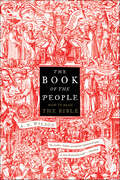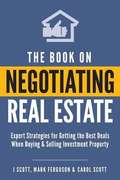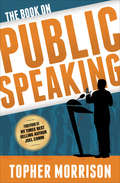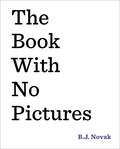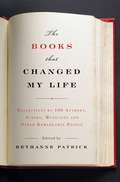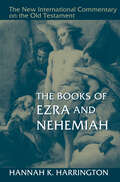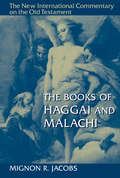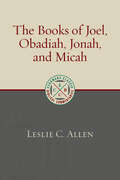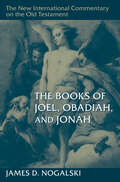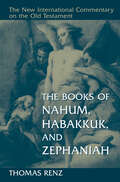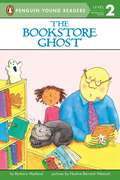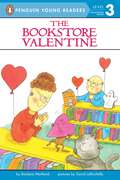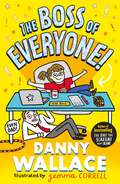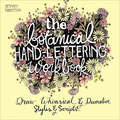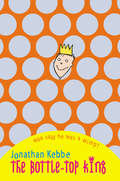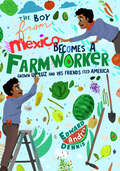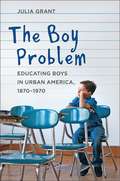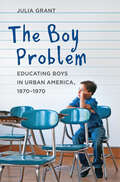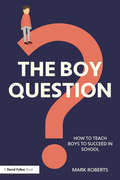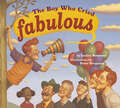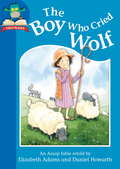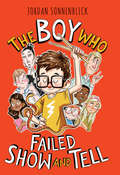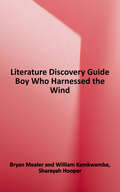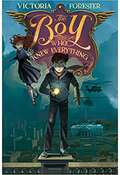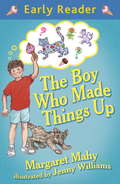- Table View
- List View
The Book of the People: How to Read the Bible
by A.N. WilsonFrom renowned historian, biographer and novelist, A.N. Wilson, a deep personal, literary, and historical exploration of the Bible. In The Book of the People, A. N. Wilson explores how readers and thinkers have approached the Bible, and how it might be read today. Charting his own relationship with the Bible over a lifetime of writing, Wilson argues that it remains relevant even in a largely secular society, as a philosophical work, a work of literature, and a cultural touchstone that the western world has answered to for nearly two thousand years: Martin Luther King was "reading the Bible" when he started the Civil Rights movement, and when Michelangelo painted the fresco cycles in the Sistine Chapel, he was "reading the Bible." Wilson challenges the way fundamentalists—whether believers or non-believers—have misused the Bible, either by neglecting and failing to recognize its cultural significance, or by using it as a weapon against those with whom they disagree. Erudite, witty and accessible, The Book of the People seeks to reclaim the Good Book as our seminal work of literature, and a book for the imagination.
The Book on Negotiating Real Estate: Expert Strategies for Getting the Best Deals When Buying & Selling Investment Property,
by Mark Ferguson J Scott Carol ScottThe principles behind successful negotiation, The psychology of building relationships to gain negotiating leverage, How to uncover and use information to tip negotiating outcomes in your favor, Strategies for defining optimal offers and counter-offers, Tactics for in-the-trenches negotiating and overcoming objections, Strategies for using concessions to get your deal to the finish line, Tips for overcoming tactics employed by those on the other side, How to overcome the challenges of making/receiving offers through agents, Tactics to renegotiate issues that arise from contract contingencies, Strategies to get the best of it when buying properties from banks and HUD.
The Book on Public Speaking
by Topher Morrison&“One of the most powerful professional speakers in America . . . reveals how he&’s earned millions onstage, on camera and in business&” (Steve Siebold, CSP, past chairman of The National Speakers Association&’s Million Dollar Speakers Group). If you look at the trends of over thirty years ago in fashion, technology, architecture, and any other industry, what was cutting edge back then has become cliché and grossly out of date now. But in the speaking industry, most people get up and still walk, talk, and sound like the 1980s motivational speakers of yesteryear. The Book on Public Speaking takes a head-on approach and challenges the status quo for business leaders that speak in front of their staff, board of directors, and the public. After reading this book you will be privy to the most current methods for speaking to an audience for maximum impact in today&’s more sophisticated and skeptical culture. If you are the type of business leader who has achieved a level of success in life and feel compelled to share your story with the world, don&’t lessen that impact by imitating outdated speaking techniques. Instead, break the mold of the speaker cliché and tap into a speaking style that is authentic, packs a punch, and leaves the audience wanting more. &“I learned some amazing presentation techniques from Topher. I&’m using them right now. They&’re awesome. You can&’t tell because you&’re reading this.&” —John Heffron, winner of The Last Comic Standing &“Morrison is crazy good at training you how to communicate on-camera so that your business gets more attention.&” —James Lavers, professional speaker, founder, &“Selling from the Screen&”
The Book with No Pictures
by B. J. NovakA #1 New York Times bestseller, this innovative and wildly funny read-aloud by award-winning humorist/actor B.J. Novak will turn any reader into a comedian—a perfect gift for any special occasion! You might think a book with no pictures seems boring and serious. Except . . . here&’s how books work. Everything written on the page has to be said by the person reading it aloud. Even if the words say . . . BLORK. Or BLUURF. Even if the words are a preposterous song about eating ants for breakfast, or just a list of astonishingly goofy sounds like BLAGGITY BLAGGITY and GLIBBITY GLOBBITY. Cleverly irreverent and irresistibly silly, The Book with No Pictures is one that kids will beg to hear again and again. (And parents will be happy to oblige.)
The Books That Changed My Life: Reflections by 100 Authors, Actors, Musicians, and Other Remarkable People
by Bethanne PatrickOne hundred of today's most prominent literary and cultural icons talk about the books that hold a special place in their hearts--that made them who they are today. Leading authors, politicians, CEOs, actors, and other notables share the books that changed their life, why they love them, and their passion with readers everywhere. Regan Arts has teamed up with the literary charity 826National, which will receive a portion of the book's proceeds to provide students ages 6-18 with opportunities to explore their creativity and improve their writing skills. Contributors include Al Roker, Carl Hiaasen, Dave Eggers, Emma Straub, Eric Idle, Fay Weldon, Fran Lebowitz, Gillian Flynn, Gregory Maguire, Jeff Kinney, Jim Shepard, Laura Lippmann, Lev Grossman, Liev Schreiber, Margaret Atwood, Mayim Bialik, Nelson DeMille, Rosanne Cash, Susan Orlean, Tim Gunn, and Tommy Hilfiger, among others.
The Books of Ezra and Nehemiah (New International Commentary on the Old Testament (NICOT))
by Hannah K. HarringtonThe books of Ezra and Nehemiah represent a significant turning point in biblical history. They tell the story not only of the rebuilding of the temple in Jerusalem but also of the resurrection of God&’s people from the death of exile. Hannah Harrington thus begins her commentary with an evocative description of these books as &“the story of a new Israel forged out of the old&” and &“the text of a people clinging to their genealogical past and attempting to preserve their heritage while walking forward into uncharted territory.&” Throughout this commentary, Harrington combines analytical research on the language and culture behind the books of Ezra and Nehemiah with challenging thoughts for the Christian church today, bringing to bear a unique perspective on these books not as the end of Old Testament history but as early documents of the Second Temple period. Accordingly, Harrington incorporates a wealth of information from other Jewish literature of the time to freshly illuminate many of the topics and issues at hand while focusing on the interpretation and use of these books for Christian life today.
The Books of Haggai and Malachi
by Mignon R. JacobsIn this commentary on Haggai and Malachi, Mignon Jacobs offers clear and insightful interpretation of the text while highlighting themes that are especially relevant to contemporary concerns, such as honoring or dishonoring God, the responsibilities of leaders, questioning God, and hearing the prophetic word in challenging times. Engaging with the latest scholarship, Jacobs provides a thorough introduction to both prophets in which she addresses questions of authorship, date, purpose, structure, and theology, followed by a new translation of the biblical text and a verse-by-verse commentary. With intertextual discussions about key aspects of the text and attention to competing perspectives, this commentary offers a rich new interpretation of Haggai and Malachi.
The Books of Joel, Obadiah, Jonah, and Micah (Eerdmans Classic Biblical Commentaries (ECBC))
by Leslie C. AllenThe eloquent and uncompromising calls for social righteousness by the Minor Prophets are familiar to many, yet the writings themselves are probably the least-studied and least-known texts of the Old Testament. Those who are familiar with these books are also aware of the historical and literary problems that plague their study. Drawing on theological, historical, and literary insights, Leslie Allen&’s commentary on Joel, Obadiah, Jonah, and Micah carefully and imaginatively reconstructs the context in which the original Hebrew audience received the prophets&’ messages. In turn, Allen shows what relevance they hold for contemporary Christians. For each of the books, Allen includes a substantial introduction, presenting and assessing a broad range of scholarship, a select bibliography, and an extensive commentary on the author&’s own translation of the text. Allen pays special attention to Micah, in which he treats at greater length many of the forms and motifs that also appear in Joel, Obadiah, and Jonah. The introductory material for Joel includes discussions of canonicity and textual criticism that apply to the entire volume.
The Books of Joel, Obadiah, and Jonah (New International Commentary on the Old Testament (NICOT))
by James D. NogalskiWhere is the line between God&’s mercy and judgment?In the latest volume of the New International Commentary on the Old Testament, James D. Nogalski offers a new translation of and commentary on several of the Minor Prophets—the books of Joel, Obadiah, and Jonah—that grapple with this theme in radically different ways. This volume includes a robust introduction for each book, delineating its textual transmission, historical context, literary form, and major themes. The introduction also discusses the role of each book within the collection of the Twelve (Minor) Prophets. The commentaries proper explain the texts verse by verse, illuminating each book&’s structure and canonical significance, yet always with an eye toward pastoral application. Academically rigorous and accessibly written, The Books of Joel, Obadiah, and Jonah is an invaluable resource for scholars, students, and pastors.
The Books of Nahum, Habakkuk, and Zephaniah (New International Commentary on the Old Testament (NICOT))
by Thomas RenzIn this commentary, Thomas Renz reads Nahum, Habakkuk, and Zephaniah as three carefully crafted writings of enduring relevance, each of which makes a vital contribution to the biblical canon. Discussing the historical settings, Renz takes up both long-standing issues, such as the relationship of Zephaniah to Josiah&’s reforms, and the socioeconomic conditions of the time suggested by recent archaeological research. The place of these writings within the Book of the Twelve is given fresh consideration, including the question of what one should make of the alleged redaction history of Nahum and Habakkuk. The author&’s careful translation of the text comes with detailed textual notes, illuminating some of the Bible&’s most outstanding poetry (Nahum) and one of the biblical chapters that is among the most difficult to translate (Habakkuk 3). The thorough verse-by-verse commentary is followed by stimulating theological reflection, opening up avenues for teaching and preaching from these prophetic writings. No matter their previous familiarity with these and other Minor Prophets, scholars, pastors, and lay readers alike will find needed guidance in working through these difficult but important books of the Bible.
The Bookstore Ghost (Penguin Young Readers, Level 2)
by Barbara MaitlandMr. Brown sells ghost books in his bookstore. But mice are scaring away the customers! Mr. Brown tells his cat to catch the mice, but she has other plans. After all, a ghost bookstore should be scary. Of course, it will be even more scary when it has its own ghost . . .
The Bookstore Valentine (Penguin Young Readers, Level 3)
by Barbara MaitlandValentine's Day is coming, and Mr. Brown's bookstore is so busy that he decides to hire someone to help out. Miss Button is perfect for the job. She loves books, she loves cats, and she even understands the special ghost in Mr. Brown's bookstore. There's only one problem. Mr. Brown and Miss Button like one another, but they're both too shy to say so! Fortunately, Cobweb the cat is there to help make sure that everyone has a happy Valentine's Day in this charming follow-up to The Bookstore Ghost and The Bookstore Burglar.
The Boss of Everyone: The brand-new comedy adventure from the author of The Day the Screens Went Blank
by Danny Wallace&‘One of the most purely enjoyable things I&’ve read!&’ Frank Cottrell-BoyceImagine if you got to be the boss of EVERYONE – even your dad! That&’s just what happens to 10-year-old Joss in this hilarious, brand-new comedy from bestselling author, comedian and presenter Danny Wallace, with illustrations throughout from Gemma Correll. Perfect for children aged 8+ and fans of David Baddiel, Stephen Mangan, David Walliams, Andy Griffiths, Jenny Pearson and Helen Rutter. Ten-year-old Joss&’s greatest ambition is to be Class Monitor at school. But she&’s about to go one step further. It&’s Take Your Kid to Work Day, and Joss&’s dad takes her to the games company he works for. When the boss calls a meeting and tells them he&’s giving his job away to the person with the best idea for a company game-changer . . . Joss sticks her hand up. And the next thing she knows, Joss is the boss. Joss is thrilled. Dad is horrified: he&’s going to have to be on his best behaviour all the time! As Joss whips everyone into shape, maybe they can all learn a lesson or two . . . even Joss herself. Warm-hearted and beautifully observed, with hilarious artwork from Gemma Correll, this family-centric comedy has massive wish-fulfilment appeal for kids and adults alike. From the author of highly acclaimed adult bestsellers YES MAN, JOIN ME and the eagerly anticipated SOMEBODY TOLD ME.DANNY WALLACE'S HILARIOUS NEW ADVENTURE OPERATION: EVIL GENIUS AVAILABLE FOR PRE-ORDER NOW!Other books by Danny Wallace:Operation: Evil GeniusThe Luckiest Kid in the WorldThe Day the Screens Went BlankHamish and the WorldstoppersHamish and the NeverpeopleHamish and the Gravity BurpHamish and the Baby BoomHamish and the Terrible Terrible Christmas and Other StoriesHamish and the Monster PatrolPraise for The Day the Screens Went Blank: 'So funny' Noel Fielding 'Brilliantly funny' Shappi Khorsandi 'Hilarious' Tim Minchin 'Warm and funny' Frank Cottrell-Boyce
The Botanical Hand Lettering Workbook: Draw Whimsical & Decorative Styles & Scripts
by Bethany RobertsonForeword INDIE Silver Winner for Crafts & Hobbies. Create exquisite hand-lettered works of art by learning how to draw ornamental fonts and flourishes.Learn the art of hand-lettering. This step-by-step workbook teaches you how to craft pretty letters and flowers of all sorts. Use your newfound botanical lettering skills to make cards, wedding invitations, banners, tags, paper bouquets, and other fun projects.“If you are someone who wants to create something beautiful with doodling and drawing, this book will inspire you and help you to learn the skills. I LOVED it!” —Tea Rose Home
The Bottle-Top King
by Jonathan KebbeRESPECT. That's what Lewis wants from his classmates. Nicknamed USELESS LEWIS or LOO BRUSH, he's fed up with his stammer, fed up that he can't pluck up the nerve to join the drama club - and fed up that the only football he gets to play is pretend matches with his collection of bottle-tops at home.Then Lewis' gangly mate Zulfi puts together a team for a five-a-side charity tournament. And he wants LEWIS to play! Can the bottle-top king burst out of his shell and show everyone the hero inside?A fresh, deliciously humourous story from a downtrodden pipsqueak who knows deep down he's a genius!
The Boy From Mexico Becomes a Farmer: Grown-up Luz and His Friends Feed America (Boy From Mexico Ser.)
by Edward Andrès Dennis&“A heartfelt tale . . . gives young readers the opportunity to gain a compassionate insight into the plight of farmworkers across the United States.&” —Ilana Peña, creator/executive producer of Diary of a Future President This early reader book unfolds a day in the life of Luz, an immigrant farmworker who, once the boy in The Boy from Mexico, now navigates the challenges of farm life with his own family. An agricultural experience. With a special focus on the avocado crop, this book serves a dual purpose: to immerse early readers in a vibrant narrative and illuminate farmworkers&’ dedicated efforts in bringing fresh produce to American tables. From farm to table. This book entertains and educates, making it an ideal choice for parents seeking food books for kids. With themes of diversity and cultural richness, it becomes a compelling addition to the collection of books for kindergarten and five-year-olds. Additionally, it is an excellent read-aloud option for kindergarten classrooms and resonates with seven-year-olds as they explore the world through literature. Immerse your child in one of the best bedtime stories, offering a narrative that transcends cultural boundaries and encourages a broader understanding of the diverse contributions to our food industry. Inside, you&’ll: Introduce your child to the world of agriculture and farm life. Help your early reader gain valuable insights into the intricate process of cultivating and harvesting food. Gain an appreciation for the vital role of farmworkers in the journey from farm to table, fostering an understanding of the labor that sustains our food supply. &“A beautiful celebration of food, history, family, traditions, and understanding.&” —Soileh Padilla Mayer, consul of Mexico in Kansas City
The Boy Problem: Educating Boys in Urban America, 1870-1970
by Julia Grant<p>America’s educational system has a problem with boys, and it’s nothing new. <p>The question of what to do with boys―the "boy problem"―has vexed educators and social commentators for more than a century. Contemporary debates about poor academic performance of boys, especially those of color, point to a myriad of reasons: inadequate and punitive schools, broken families, poverty, and cultural conflicts. Julia Grant offers a historical perspective on these debates and reveals that it is a perennial issue in American schooling that says much about gender and education today. <p>Since the birth of compulsory schooling, educators have contended with what exactly to do with boys of immigrant, poor, minority backgrounds. Initially, public schools developed vocational education and organized athletics and technical schools as well as evening and summer continuation schools in response to the concern that the American culture of masculinity devalued academic success in school. <p>Urban educators sought ways to deal with the "bad boys"―almost exclusively poor, immigrant, or migrant―who skipped school, exhibited behavioral problems when they attended, and sometimes landed in special education classes and reformatory institutions. The problems these boys posed led to accommodations in public education and juvenile justice system. <p>This historical study sheds light on contemporary concerns over the academic performance of boys of color who now flounder in school or languish in the juvenile justice system. Grant's cogent analysis will interest education policy-makers and educators, as well as scholars of the history of education, childhood, gender studies, American studies, and urban history.</p>
The Boy Problem: Educating Boys in Urban America, 1870–1970
by Julia GrantA historical perspective on the factors affecting boys’ relationships with school and the criminal justice system.Outstanding Academic Title, ChoiceAmerica’s educational system has a problem with boys, and it’s nothing new.The question of what to do with boys—the "boy problem"—has vexed educators and social commentators for more than a century. Contemporary debates about poor academic performance of boys, especially those of color, point to a myriad of reasons: inadequate and punitive schools, broken families, poverty, and cultural conflicts. Julia Grant offers a historical perspective on these debates and reveals that it is a perennial issue in American schooling that says much about gender and education today.Since the birth of compulsory schooling, educators have contended with what exactly to do with boys of immigrant, poor, minority backgrounds. Initially, public schools developed vocational education and organized athletics and technical schools as well as evening and summer continuation schools in response to the concern that the American culture of masculinity devalued academic success in school. Urban educators sought ways to deal with the "bad boys"—almost exclusively poor, immigrant, or migrant—who skipped school, exhibited behavioral problems when they attended, and sometimes landed in special education classes and reformatory institutions. The problems these boys posed led to accommodations in public education and juvenile justice system.This historical study sheds light on contemporary concerns over the academic performance of boys of color who now flounder in school or languish in the juvenile justice system. Grant's cogent analysis will interest education policy-makers and educators, as well as scholars of the history of education, childhood, gender studies, American studies, and urban history.
The Boy Question: How To Teach Boys To Succeed In School
by Mark RobertsFollowing on from the huge success of Boys Don’t Try? this essential new book answers nine key questions about how teachers and schools can best tackle boys’ academic underperformance. For decades schools have grappled with the most significant barriers to male academic success: a lack of motivation to succeed, poor attitudes to learning, lower literacy levels and a reluctance to read for pleasure or write at length. In this compelling book, Mark Roberts provides clear answers about how teachers can tackle ‘The Boy Question’. Each chapter answers a frequently asked question about how best to teach boys, outlining the issue and demonstrating what can be done about it. Informed by a wealth of research and the author’s personal experience of successfully teaching boys, this book offers an abundance of practical advice for the busy classroom teacher. It will shine a light on what makes boys tick and how we can design effective curriculums to ensure they can best acquire powerful knowledge. With practical advice and examples to help address anti-social attitudes and stem the cycle of boys’ underachievement, this is essential reading for all teachers and school leaders.
The Boy Who Cried Fabulous
by Leslea NewmanThe only thing Roger likes better than exploring the world around him is describing it. And Roger describes most things as fabulous! But his parents have a different view. They want Roger to see things the way they do, so they ban "fabulous" from his vocabulary. Fabulously illustrated by Peter Ferguson, this cheerful tale will have children rejoicing along with Roger at all the fabulous--no, marvelous! no, dazzling!--things that await him when he steps outside.
The Boy Who Cried Wolf (Must Know Stories: Level 1)
by Elizabeth AdamsWhen the shepherd boy gets bored, he shouts "Wolf!" and all the villagers come running. What will happen when a wolf really does appear?A beautifully illustrated retelling of this favourite traditional story. Based on the original Aesop fable, this provides a gentle introduction to the importance of telling the truth.Must Know Stories includes favourite tales, celebrating the diversity of our literary heritage. Level 1 stories are told in under 500 words, for children to read independently.
The Boy Who Failed Show and Tell
by Jordan SonnenblickIn a typical school year, every kid has one or two things go wrong. But for Jordan, there's A LOT going wrong ALL THE TIME.Take this year. Here are some of the thing going wrong:-- His teacher hates him. Like, really hates him. Like, is totally out to get him even when he's trying to be good, and is willing to fail him on the simplest things, like show and tell.-- He has a slight breathing problem because of his asthma. And breathing is never really an optional activity.-- His pet snake has given birth to way, way, way too many baby snakes, all who need a home.-- He is finding that becoming The World's Best Drummer in no time whatsoever is maybe not the easiest goal.-- There are bullies ready to stomp him when all he has to defend himself with is a lunchbox.And all this doesn't even include the freak swing set accident, the fears inside his head, or the funniest class presentation ever. By keeping his cool (some of the time), banging on the drums (a lot), and keeping his sense of humor (all the time), Jordan's going to try to make it through the year . . . and grow up to write a book about it!
The Boy Who Harnessed the Wind - Literature Discovery Guide
by William Kamkwamba Bryan Mealer Sharayah HooperLevel 2 Discovery Guides are recommended for a range of primary (grades 3 to 5) students who have acquired the foundational skills to independently read and respond to a simple piece of literature. Each guide is designed to be completed in five weeks, which allows students to comfortably work through six units in a typical school year.
The Boy Who Knew Everything (Piper Mccloud #2)
by Victoria ForesterAn epic modern fantasy about an unforgettable friendship. <P><P> There is a prophecy. <P><P> It speaks of a girl who can fly and a boy who knows everything. The prophecy says that they have the power to bring about great change . . . . The boy is Conrad Harrington III. The girl is Piper McCloud. They need their talents now, more than ever, if they are to save the world-and themselves. <P><P> Victoria Forester does not disappoint in The Boy Who Knew Everything, the long-awaited sequel to New York Times-bestselling The Girl Who Could Fly, which Stephenie Meyer praised as "the oddest/sweetest mix of Little House on the Prairie and X-Men." This title has Common Core connections.
The Boy Who Made Things Up (Early Reader)
by Margaret MahyEarly Readers are stepping stones from picture books to reading books. A blue Early Reader is perfect for sharing and reading together. A red Early Reader is the next step on your reading journey.Michael loves to make things up, and when he and his dad go for a walk, they can't believe what they see. Islands. Giants. Even mermaids...A brand-new full colour Early Reader edition of this favourite story, with charming illustrations by Jenny Williams, illustrator of the beautiful and classic picture book, A LION IN THE MEADOW.
